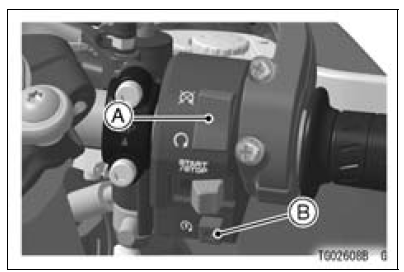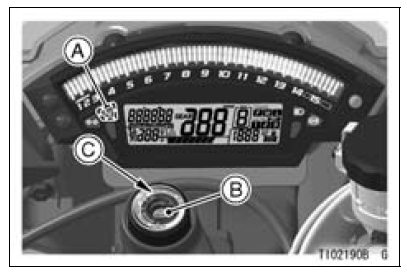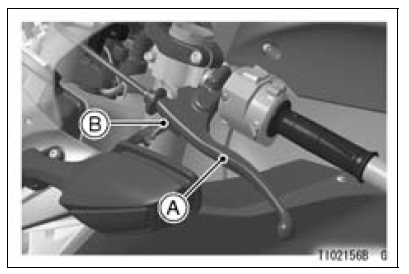

Check that the engine stop switch is
in the 
position.

A. Engine Stop Switch
B. Starter Button

A. Neutral Indicator Light
B. Ignition Switch
C. “ON” position
NOTE
After the meter operation check, leaving the throttle completely closed, push the starter button.
NOTICE
Do not operate the starter continuously for more than 5 seconds, or the starter will overheat and the battery power will drop temporarily. Wait 15 seconds between each operation of the starter to let it cool and the battery power recover.
NOTE

A. Clutch Lever
B. Starter Lockout Switch
NOTICE
Do not let the engine idle longer than five minutes, or engine overheating and damage may occur.
 Jump starting
Jump startingEvaporative Emission Control System Inspection (CAL and SEA-B1 Models)
Inspect the canister as follows.
Remove the upper fairing assembly (see Upper Fairing
Assembly Removal in the Frame chapter).
Remove the canister [A].
Visually inspect the canister for cracks or other damage.
If the canister has any cracks or bad damage, replace it
with a new one.
NO ...
Sidestand Switch Operation Inspection
Raise the rear wheel off the ground with the stand (see
Rear Wheel Removal in the Wheels/Tires chapter).
Inspect the sidestand switch [A] operation accordance to
below table.
Sidestand Switch Operation
If the sidestand switch operation does not work, inspect
or replace the foll ...
Clutch Installation
Apply engine oil to the needle bearing [A] and the sleeve
[B].
Install:
Needle Bearing
Sleeve
Install the clutch housing [A].
Fit the holes [B] and projections [C].
Engage the clutch housing gear and the crankshaft primary
gear.
Install the spacer [A] and the clutch ...